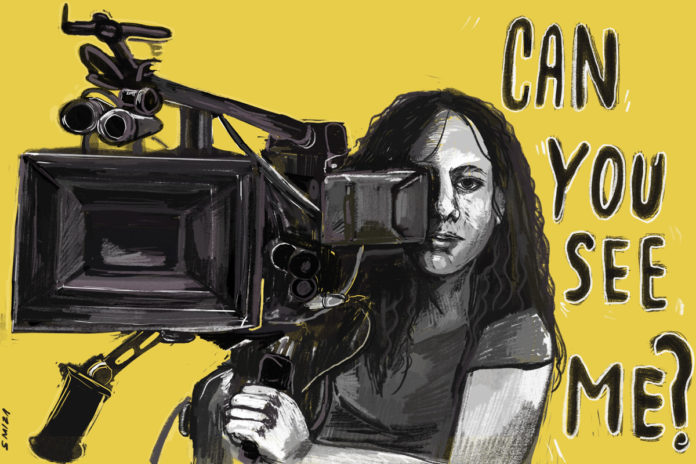The lack of opportunities and recognition for female-identifying filmmakers is a deep-rooted issue in the film industry, say several female filmmakers.
This disparity has had ripple effects right here in Ottawa.
Last year, Women in View’s On Screen report analyzed the content produced by women in the Canadian film industry since 2014. The report sheds light on the gender inequalities in Canadian film.
Women, especially women of colour and Indigenous women, remain under-employed in film and TV productions in Canada, awarded under 25 per cent of contracts in Canadian film, according to the report.
“A lot of people come into this industry and are automatically taken more seriously because they are men, and it’s really frustrating to watch,” said Emily Ramsay, an independent producer and filmmaker in Ottawa.
Ramsa said she is often told she is more emotional than her male colleagues and therefore should not direct.
“I don’t see why one person should be given an opportunity over another because of their gender,” said Ramsay.
Ramsay is the executive director of Digi60, a grassroots film festival dedicated to representation, equity, and diversity in Ottawa film. The festival is just one of many initiatives in Ottawa working to elevate female-identifying filmmakers.
As both an immigrant and a woman in this industry, I feel like I have to prove myself over and over again in order to be taken seriously or to be recognized as someone who brings value. -Hingman leung, filmmaker
In the Spring 2019 festival, 60 per cent of participants identified as female, and every main award went to women.
“This is an example that shows how the more opportunities there are for women to participate, the more opportunities they will have to excel,” said Ramsay. “In Ottawa, what I would love to see is more female-identified directors getting funding and opportunities for their work.”
But opportunities are often hard to come by in Canadian film, especially for female filmmakers of colour. In 2017, women of colour only received four per cent of film production contracts, and only one per cent of the contracts went to Indigenous women.
Both on and behind the screen, the voices of women of colour are underrepresented in Ottawa and Canadian film, said Hingman Leung, an independent filmmaker based in Ottawa.
“As both an immigrant and a woman in this industry, I feel like I have to prove myself over and over again in order to be taken seriously or to be recognized as someone who brings value,” said Leung.
The report found that Canadian films produced by white women, women of colour and Indigenous women were consistently gender-balanced, and employed more diverse writers, directors, and cinematographers.
“I think increased representation will play a big part. Hiring quotas and grants can only get us halfway there,” explained Leung.
“Women of colour have to be able to see themselves in the industry and be empowered to speak our truth in order to meet the other half of the way.”
In 2016, CBC announced its commitment to improve gender equity and diversity by increasing the number of women directing CBC scripted television series to 50 per cent. But despite this stride for change, only 2.3 per cent of contracts went to women of colour.
“We shouldn’t have to be fighting for a seat at the table, there’s enough room for everyone,” said Maissa Houri, an Arab-Canadian actress and director based in Ottawa.
Houri often finds she is only given auditions for stereotypical Muslim roles such as refugees and terrorists, and said, “We need to break those stereotypes and share these regular stories.”
“I don’t see why one person should be given an opportunity over another because of their gender.” – Emily ramsay, filmmaker
She has chosen to change the narrative about Muslim women in film by writing her own story.
She is directing a television series called Dirty Love, which is about a first-generation Arab-Canadian Muslim woman who sells sex toys.
“I didn’t have anyone to relate to in film while growing up,” said Houri. “We are such a diverse culture here in Canada, yet our TV doesn’t reflect that.”
Houri thinks back to the times she spent hidden in an office cubicle, after giving up on her dream to pursue film because of the lack of opportunities women have in the film industry.
“We don’t have the same stories as men, and we need to be able to tell them. We have the experience, but we just need the opportunities,” said Houri.
Despite the statistics that could discourage women of colour from pursuing a career in film, Houri had two motivations that reminded her of the importance of living out her dreams: her two young daughters.
“If I can’t live my dream, how can I push my daughters to reach theirs?” said Houri. “I do it to show them that they can have it all if they work hard, stay motivated, and pursue their dreams.”
As the Ottawa film community enters a new decade, Leung said the women behind the screens have big plans for the years to come.
“Ottawa can expect us to wake up and band together. We’re already awake, and we’re ready to shake things up.”
Featured graphic by Sara Mizannojehdehi.






